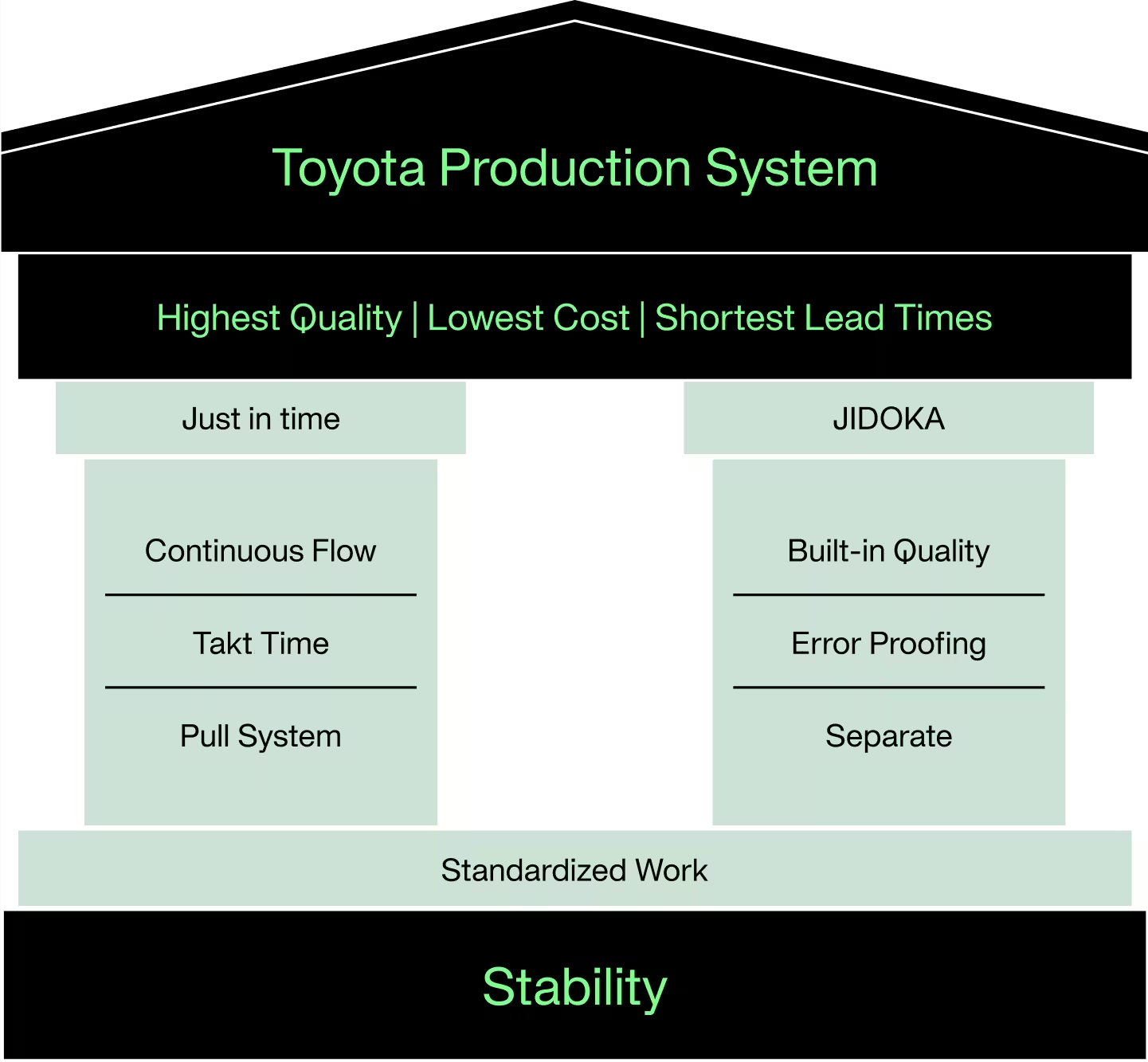Outbuild is online scheduling software to work together on connected project schedules and look-aheads, enabling everyone to move faster.
Key Takeaways
Table of contents
- The Backstory on Lean Construction
- What is Lean Construction?
- Lean Construction Principles
- Benefits of Lean Construction
- Lean Construction Techniques, Methods & Tools
- Notable Projects Built With Lean Construction Principles
- The Role of the Lean Construction Institute (LCI)
- Getting Started with Lean Construction
Let’s be honest with ourselves. On even the most successful projects, there is some level of time, materials, or effort that gets wasted.
The combination of multiple companies, each with teams working separately on their specialized tasks, yet fully dependent on the work done before and after them, often leads to communication breakdowns. These breakdowns cause delays and rework otherwise known as waste.
Waste in construction is almost always a result of a lack of efficient processes. The concept of lean building seeks to address these issues by reducing the amount of waste while still maintaining the highest level of quality.
The concept of “lean” in business can be traced back to the Toyota Production System, which was developed by Taiichi Ohno and Eiji Toyoda in the 1950s. This system focused on minimizing waste and increasing efficiency in manufacturing processes.

Lean building principles were later adapted for use in other industries, including construction. You’ll also hear this approach called lean in building or lean building construction when teams apply it directly on jobsites.
What does lean construction mean? In simple terms, lean in construction is a management philosophy that focuses on reducing waste and maximizing value in construction processes.
It aims to deliver projects faster, cheaper, and with higher quality by eliminating non-value-adding activities and continuously improving workflows.
Said simply, lean construction management uses a repeatable lean construction process so teams plan the work, manage handoffs, and learn from each cycle.
Lean practices in construction was first introduced in 1993 by the International Group for Lean Construction (IGLC) as an alternative approach to traditional project management methods.
The IGLC believed that the traditional approach, which relied heavily on large inventories and long lead times, was not compatible with the fast-paced and dynamic nature of construction projects.
People often ask, “What is lean construction principles?” It’s the set of guiding ideas that help teams cut waste and deliver value. The lean construction principles below are practical, field-ready, and easy to teach. You’ll also hear them called lean principles in construction or lean building principles.
Let’s define lean construction by diving into the five principles:
The 5 principles of lean construction:
1. Define customer value
Know what the owner and end users actually need—schedule targets, cost limits, quality must-haves. Say it clearly and share it with every crew. When value is clear, waste stands out.
Cloud-based schedules keep everyone aligned by showing clear goals and priorities in one place.
2. Map the value stream
Map out the steps from design to install to turnover. Find handoffs, lead times, and common roadblocks. Remove steps that don’t add value. This is where many lean construction practices start paying off.
Visual planning tools make it easy to see the full process and spot issues before they slow down the job.
3. Create flow
Line up work so crews can keep moving without stop-and-go. Right people, right materials, right sequence. Use layout zones, standard work, and clean staging to keep the path clear. Do this through lean scheduling and planning.
Dynamic scheduling helps balance workloads and keep crews moving smoothly from one task to the next.
4. Use pull (don’t push)
Plan from milestones backward. With the Last Planner® System, foremen make weekly promises the team can keep. Materials and prefabricated assemblies arrive just in time, not “just in case.”
Real-time planning lets teams commit to realistic weekly goals and track progress as the work happens.
5. Pursue perfection with small fixes
Track PPC lean construction metrics and reasons for variance. Tweak the plan, then run the next cycle.
Analytics makes it easy to see where plans went off track so teams can fix issues fast and improve over time.
Waste Still Matters (DOWNTIME)
The principles of lean construction work best when teams also watch the 8 wastes of lean construction (DOWNTIME: Defects, Overproduction, Waiting, Non-utilized talent, Transportation, Inventory, Motion, Extra processing). Teach crews to spot waste in real time and remove it at the source.

Collaboration Ties It Together
Lean only works when people work together. Designers, GCs, trades, and suppliers share realistic plans, surface constraints early, and agree on handoffs. Clear roles and steady leadership keep the plan honest and the schedule predictable.
These lean construction principles are simple, but they’re powerful when used every week on site. This can lead to improved communication, fewer delays, and better decision-making.
Lean is more than cutting waste. It’s about creating reliable flow and steady outcomes. Common benefits of lean construction include:
- Shorter, steadier schedules through better handoffs and takt planning.
- Fewer RFIs and change orders because teams surface constraints early.
- Lower total cost from less rework, right-sized inventory, and smoother logistics.
- Higher quality and safety thanks to standard work, visual controls, and daily learning.
- Stronger team culture—clear commitments, data-driven planning, and shared wins.
If leadership needs a quick summary, point to schedule predictability, cost control, and field adoption as the headline benefits.
Teams mix several lean construction techniques, lean construction methods, and tools:
- Last Planner® System and lean pull planning: Plan from milestones backward, make reliable weekly commitments, and track Percent Plan Complete (PPC).
- Look-ahead planning and constraint logs: The backbone of lean construction scheduling. Keep a 3–6 week window, clear roadblocks, and lock sequences.

- Just in time lean construction and prefabrication: Order materials and assemblies to match the plan, cut on-site inventory, and speed installation.
- Takt planning: Balance crews across zones so flow is even and predictable.
- Value stream mapping and A3 problem solving: See the whole process and fix root causes.
- 5S and visual management: Sort, set in order, shine, standardize, sustain—make the right way visible on site.
- Target Value Delivery and set-based design: Work to an allowable cost and explore options before locking in.
- Simple digital supports: Field-ready boards, mobile checklists, and connected schedules help teams run the lean construction methodology day to day.
These lean construction methods work best when everyone has access to the same plan and real-time updates. Outbuild brings scheduling and planning into one simple platform so teams can plan, track, and adjust without the usual chaos.
Outbuild makes it easy to get started with lean planning workflows, even if the project schedule was already built to include field-level tasks. Teams can safely move detailed activities from the master schedule into the lookahead, preview changes before saving, and create a backup if needed. All key data including dates, durations, responsibilities, and tags stay intact, helping crews keep the master plan lean while managing day-to-day work where it belongs: in the lookahead.
Projects that utilized lean construction principles often make headlines for efficiency and cost savings. Here are a few notable lean construction examples that used lean construction tools for success:
The London Olympics Stadium in 2012 was one of the most iconic projects built using lean principles. The project achieved a 30% cost saving and a 50% reduction in construction duration through the adoption of lean construction methods such as value-stream mapping, Last Planner System, and 5S workplace organization.

San Francisco’s TransBay Transit Center is another example of a successful project that utilized lean construction principles. The team employed strategies such as prefabrication, modularization, pull systems, and real-time information exchange in order to reduce waste and improve the project efficiency.
The Burj Khalifa in Dubai is the tallest skyscraper in the world and it was built using lean construction techniques. Lean practices such as prefabrication, just-in-time construction delivery system and 5S workplace organization were adopted in order to reduce costs and the duration of the programme. The project was completed on time with a 30% cost saving.
The Grand Egyptian Museum is one more example of successful implementation of lean construction principles. The project was delivered on time and within budget owing to the adoption of modern planning techniques such as target costing, work standardization, total quality management, just-in-time delivery and team collaboration. These methods reduced costs and improved safety standards while ensuring project deadlines were met.
The Edge, Amsterdam, this building is often cited for its sustainable design and smart technology, which aligns with lean principles focusing on efficiency and value. The Edge is known as one of the greenest buildings in the world.
The Shard, London the Europe's tallest skyscraper when it was completed, The Shard is another example where lean construction methods helped manage the complexity of its design and construction, maximizing value and minimizing waste while maintaining high safety standards.
Denver International Airport Hotel and Transit Center, this project used lean construction practices extensively, particularly for integrating different project teams and streamlining the construction processes involved in building a significant addition to an already operating major international airport.
BMW’s Leipzig Plant, Germany. Although not a building in the conventional sense, this industrial complex utilized lean construction principles in its assembly plant’s construction, focusing on process optimization, waste reduction, and efficient design.
Founded in 1997, the Lean Construction Institute (LCI) is a non-profit organization dedicated to promoting lean principles in the construction industry. LCI provides resources, training, and education to help contractors, owners, and designers adopt lean practices and drive continuous improvement.

Their goal is to transform the construction industry by creating a culture of collaboration, efficiency, and waste reduction.
Lean construction has seen widespread adoption in the construction industry, with many companies implementing lean principles in their project management processes.
However, it is important to note that lean construction is not a one-size-fits-all approach and must be tailored to fit each project's unique characteristics. Light structure, clear roles, steady leadership, and regular retros, helps teams avoid these pitfalls.
A great way to dive into lean practices is to have a few ambitious team members sign up for lean construction courses. There are even great and enjoyable lean construction podcasts out there chalk full of great information.
Once you have a few company champions, you can lean on them to help train the rest of your team. The benefit? You can promote that your team is educated on the most efficient way to build a project and that you offer lean construction services.
And, if you’re curious about how Lean and Six Sigma work together in construction, there are courses for that too. Lean Six Sigma in Construction builds on the ideas of lean construction.
Six Sigma focuses on making processes so accurate that mistakes are extremely rare, just six standard deviations from the average. Think of it like this: if you ordered one million bricks for a project, only 3 or 4 would be defective. The goal of Six Sigma is to get as close to perfect quality as possible.
Overall, the lean construction method has the potential to transform the construction industry and drive success in future projects.
The right tools make lean planning easier to adopt and stick with. Outbuild gives teams a simple, connected way to plan, track, and improve schedules so lean practices actually work on the jobsite.
Want to learn more? Book a demo or start your 14-day free trial today.
People often ask, “What is lean construction principles?” It’s the set of guiding ideas that help teams cut waste and deliver value. The lean construction principles below are practical, field-ready, and easy to teach. You’ll also hear them called lean principles in construction or lean building principles.
Let’s define lean construction by diving into the five principles:
The 5 principles of lean construction:
1. Define customer value
Know what the owner and end users actually need—schedule targets, cost limits, quality must-haves. Say it clearly and share it with every crew. When value is clear, waste stands out.
Cloud-based schedules keep everyone aligned by showing clear goals and priorities in one place.
2. Map the value stream
Map out the steps from design to install to turnover. Find handoffs, lead times, and common roadblocks. Remove steps that don’t add value. This is where many lean construction practices start paying off.
Visual planning tools make it easy to see the full process and spot issues before they slow down the job.
3. Create flow
Line up work so crews can keep moving without stop-and-go. Right people, right materials, right sequence. Use layout zones, standard work, and clean staging to keep the path clear. Do this through lean scheduling and planning.
Dynamic scheduling helps balance workloads and keep crews moving smoothly from one task to the next.
4. Use pull (don’t push)
Plan from milestones backward. With the Last Planner® System, foremen make weekly promises the team can keep. Materials and prefabricated assemblies arrive just in time, not “just in case.”
Real-time planning lets teams commit to realistic weekly goals and track progress as the work happens.
5. Pursue perfection with small fixes
Track PPC lean construction metrics and reasons for variance. Tweak the plan, then run the next cycle.
Analytics makes it easy to see where plans went off track so teams can fix issues fast and improve over time.
Waste Still Matters (DOWNTIME)
The principles of lean construction work best when teams also watch the 8 wastes of lean construction (DOWNTIME: Defects, Overproduction, Waiting, Non-utilized talent, Transportation, Inventory, Motion, Extra processing). Teach crews to spot waste in real time and remove it at the source.

Collaboration Ties It Together
Lean only works when people work together. Designers, GCs, trades, and suppliers share realistic plans, surface constraints early, and agree on handoffs. Clear roles and steady leadership keep the plan honest and the schedule predictable.
These lean construction principles are simple, but they’re powerful when used every week on site. This can lead to improved communication, fewer delays, and better decision-making.
Lean is more than cutting waste. It’s about creating reliable flow and steady outcomes. Common benefits of lean construction include:
- Shorter, steadier schedules through better handoffs and takt planning.
- Fewer RFIs and change orders because teams surface constraints early.
- Lower total cost from less rework, right-sized inventory, and smoother logistics.
- Higher quality and safety thanks to standard work, visual controls, and daily learning.
- Stronger team culture—clear commitments, data-driven planning, and shared wins.
If leadership needs a quick summary, point to schedule predictability, cost control, and field adoption as the headline benefits.
Teams mix several lean construction techniques, lean construction methods, and tools:
- Last Planner® System and lean pull planning: Plan from milestones backward, make reliable weekly commitments, and track Percent Plan Complete (PPC).
- Look-ahead planning and constraint logs: The backbone of lean construction scheduling. Keep a 3–6 week window, clear roadblocks, and lock sequences.

- Just in time lean construction and prefabrication: Order materials and assemblies to match the plan, cut on-site inventory, and speed installation.
- Takt planning: Balance crews across zones so flow is even and predictable.
- Value stream mapping and A3 problem solving: See the whole process and fix root causes.
- 5S and visual management: Sort, set in order, shine, standardize, sustain—make the right way visible on site.
- Target Value Delivery and set-based design: Work to an allowable cost and explore options before locking in.
- Simple digital supports: Field-ready boards, mobile checklists, and connected schedules help teams run the lean construction methodology day to day.
These lean construction methods work best when everyone has access to the same plan and real-time updates. Outbuild brings scheduling and planning into one simple platform so teams can plan, track, and adjust without the usual chaos.
Outbuild makes it easy to get started with lean planning workflows, even if the project schedule was already built to include field-level tasks. Teams can safely move detailed activities from the master schedule into the lookahead, preview changes before saving, and create a backup if needed. All key data including dates, durations, responsibilities, and tags stay intact, helping crews keep the master plan lean while managing day-to-day work where it belongs: in the lookahead.
Projects that utilized lean construction principles often make headlines for efficiency and cost savings. Here are a few notable lean construction examples that used lean construction tools for success:
The London Olympics Stadium in 2012 was one of the most iconic projects built using lean principles. The project achieved a 30% cost saving and a 50% reduction in construction duration through the adoption of lean construction methods such as value-stream mapping, Last Planner System, and 5S workplace organization.

San Francisco’s TransBay Transit Center is another example of a successful project that utilized lean construction principles. The team employed strategies such as prefabrication, modularization, pull systems, and real-time information exchange in order to reduce waste and improve the project efficiency.
The Burj Khalifa in Dubai is the tallest skyscraper in the world and it was built using lean construction techniques. Lean practices such as prefabrication, just-in-time construction delivery system and 5S workplace organization were adopted in order to reduce costs and the duration of the programme. The project was completed on time with a 30% cost saving.
The Grand Egyptian Museum is one more example of successful implementation of lean construction principles. The project was delivered on time and within budget owing to the adoption of modern planning techniques such as target costing, work standardization, total quality management, just-in-time delivery and team collaboration. These methods reduced costs and improved safety standards while ensuring project deadlines were met.
The Edge, Amsterdam, this building is often cited for its sustainable design and smart technology, which aligns with lean principles focusing on efficiency and value. The Edge is known as one of the greenest buildings in the world.
The Shard, London the Europe's tallest skyscraper when it was completed, The Shard is another example where lean construction methods helped manage the complexity of its design and construction, maximizing value and minimizing waste while maintaining high safety standards.
Denver International Airport Hotel and Transit Center, this project used lean construction practices extensively, particularly for integrating different project teams and streamlining the construction processes involved in building a significant addition to an already operating major international airport.
BMW’s Leipzig Plant, Germany. Although not a building in the conventional sense, this industrial complex utilized lean construction principles in its assembly plant’s construction, focusing on process optimization, waste reduction, and efficient design.
Founded in 1997, the Lean Construction Institute (LCI) is a non-profit organization dedicated to promoting lean principles in the construction industry. LCI provides resources, training, and education to help contractors, owners, and designers adopt lean practices and drive continuous improvement.

Their goal is to transform the construction industry by creating a culture of collaboration, efficiency, and waste reduction.
Lean construction has seen widespread adoption in the construction industry, with many companies implementing lean principles in their project management processes.
However, it is important to note that lean construction is not a one-size-fits-all approach and must be tailored to fit each project's unique characteristics. Light structure, clear roles, steady leadership, and regular retros, helps teams avoid these pitfalls.
A great way to dive into lean practices is to have a few ambitious team members sign up for lean construction courses. There are even great and enjoyable lean construction podcasts out there chalk full of great information.
Once you have a few company champions, you can lean on them to help train the rest of your team. The benefit? You can promote that your team is educated on the most efficient way to build a project and that you offer lean construction services.
And, if you’re curious about how Lean and Six Sigma work together in construction, there are courses for that too. Lean Six Sigma in Construction builds on the ideas of lean construction.
Six Sigma focuses on making processes so accurate that mistakes are extremely rare, just six standard deviations from the average. Think of it like this: if you ordered one million bricks for a project, only 3 or 4 would be defective. The goal of Six Sigma is to get as close to perfect quality as possible.
Overall, the lean construction method has the potential to transform the construction industry and drive success in future projects.
The right tools make lean planning easier to adopt and stick with. Outbuild gives teams a simple, connected way to plan, track, and improve schedules so lean practices actually work on the jobsite.
Want to learn more? Book a demo or start your 14-day free trial today.
Frequently Asked Questions
Yes, lean building methods cut waste, improve teamwork, and help projects finish on time and within budget. The results depend on team buy-in and steady leadership.
It cuts waste like unused materials, delays, and rework. Lean building construction teams plan better and order just what’s needed. That lowers cost and keeps quality high.
Many teams struggle with changing old habits. It takes training, clear roles, and a few quick wins to build trust. Start small, then grow as the team sees results.
The 5 principles of lean construction include defining customer value, mapping the value stream, creating flow, planning from milestones and pursuing perfection.
Pull planning, look-ahead scheduling, and takt planning help keep work moving smoothly. Just in time lean construction also limits on-site clutter. These techniques make schedules more predictable.
Related Articles
Ready to see Outbuild?
Join hundreds of contractors from 10+ countries that are saving money by scheduling better










